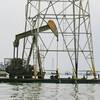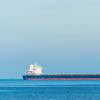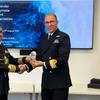On the Elbe River, the famous port of Hamburg's Nautical Institute had its final intake this year due to a shortage of prospective students. From now on it will be known as the Hamburg Institute for Ship Handling and Simulation, but for many years it sent highly trained young people to sea. Some of those, after gaining years of deep sea experience, returned to Hamburg to become river and docking pilots. The Port has two pilot stations and two pilotage authorities. The Harbor Pilots (Hafenlotsenbrüüderschaft), of which there are about 45, work from a beautiful brick building complete with clock tower on a point at the entrance to the port on the south side of the river where most of the docks are located. The river pilots' association (Lotsenbrüderschaft Elbe), which includes the sea pilots and has about 240 members, are located just down and across the river in a large house barely distinguishable from its luxurious neighbors in the tonier part of this very beautiful city.
Entering the Hanseatic port of Hamburg from the sea is a three-stage proposition. As the ships come into the German Bight from the North Sea, they contact a pilot from the sea station, which is the recently launched 164 x 74-ft. (49.9 x 22.5-m) SWATH station ship Elbe. The pilots are boarded from a (7.5-m) pilot boat or a (25-m) version of the SWATH that has effectively done away with the need for and use of helicopters for boarding unless specifically requested by the ship. Forty n.m. from the pilot ship and just inside the estuary, on the north shore where the Kiel Canal connects from the Baltic Sea, a pilot boat brings a river pilot out to exchange places with the sea pilot. This pilot then takes the ship the remaining 36 miles on up the river to the port entrance where one or more docking pilots take over.
Out bound the reverse order is followed. Just ahead of the Easter weekend last March 27, one of the harbor pilots handed the 3,764 teu containership Teng He over to river pilot Capt. Jens Heesch, who had boarded from a launch in front of the River Pilot station. Although the port is 60 miles from the North Sea some parts of it are below sea level. With 15-ft. tides common, the river typically reverses its flow to over three knots on a flood tide. A strong westerly blowing in from the North Sea can add another six feet to these tides and frequently threatens flooding in the lower port areas. On this March afternoon with the full moon just one day away, the tide is flooding just under two knots and the ship is making 12.2 knots over the bottom as it heads down river. The north shore, with its sumptuous homes, many of which were built over the centuries by Hamburg shipping magnates, is lined with swimming beaches and marinas, both of which require the pilots' care. Especially the swimming beaches in summer, says Heesch, as the ship's effect in surging and sucking water off the beach can cause a dangerous situation. It requires precision to move a large ship through water while allowing for the presence of a fragile human body in the same system. Opposite the huge Airbus fabrication facility on the south shore, Capt. Heesch calls the Port of Hamburg vessel traffic manager center located in the Harbor Pilot's building, to report that he is leaving the port's jurisdictional area. Then he checks in with the Brunsbüttel Vessel Traffic System which is operated from a state-of-the-art facility at the mouth of the Kiel Canal Brunsbüttel reports on the river traffic as Heesch brings the Teng He on course with the aide of the first of a series of leading or range lights that aide ships in maintaining mid channel for the whole length of the lower river.
Also on this stretch of the river at the lower end of Hamburg's residential suburbs, is the restaurant Schulauer Fährhaus where a maritime flag pole displays a Chinese flag and huge loud speakers play the Chinese national anthem to honor the registry of the Teng He. The COSCO Container Line vessel's Captain Yang Renzhong walks out on the starboard bridge wing to wave his appreciation of the gesture. "Sometimes the captains show a little tear," says Heesch of the tradition marking a ship's entrance and exit from Hamburg.
With a number of years in deep sea service himself, Heesch is sympathetic to the emotions of the visiting captains. Following his sea duty, he has been 18 years in the Elbe pilotage, with all but the last of those spent as a sea pilot. Most of the pilots working in the river between Hamburg and Brunsbüttel have spent time in the physically more demanding leg in from the German Bight. Typically new pilots train for both the sea leg and the estuary but then start at sea. When they make the move inside, the pilots take an update to the training for the transition to the river.
An hour after leaving the Port of Hamburg controlled area, the Teng He passes a Dow Chemical plant that takes advantage of huge reserves of underground salt in the area. This is one of the few shipping docks on the lower river. Once clear of the plant, Heesch asks for another 10 revolutions on the main engine to bring the ship up to its 16-knot maneuver speed. The river is widening now but the navigation channel is maintained at a 820 x 989-ft. (250 to 300-m) width from Hamburg to Brunsbüttel with the depth dredged in a few spots as required to maintain a 114-ft. (14.4-m) low water depth allowing a 42-ft. (12.8-m) maximum ship draft on low water and 49-ft. (15.1-m) draft on high water. With the tide still flooding and the Teng He drawing 37 ft. (11.3 m), Heesch keeps the speed in check to avoid any possibility of "squat" as the ship passes over some of the shallower areas. As the tide reaches high water slack and the ship reaches slightly deeper water 20 minutes later, he increases the vessel’s speed to 17.5 knots just under its full sea speed. The pilot's years of deep sea experience are revealed as he tells not only of ocean crossings, but of watching other pilots work in the tides and currents on the Congo River and grounding a ship just inside Vancouver's Lions Gate Bridge.
The land along the lower river is uniformly flat with few villages on its flood prone expanse, but a few miles above Brunsbüttel, the mouth of the smaller Stör River is protected by a flood gate. Over the grasslands the superstructure of a small coaster containership rises from the dry-dock at the Peterswerft Wewelsfleth GmbH. shipyard that represents the long tradition of German shipbuilding. While suffering from lower cost Asian competition, the yards are active in specialized ships. But few large containerships like the Teng He are built here now. The 905 x 106-ft. (276 x 32.3-m) Teng He was built in Germany by Bremer Vulkan Ag in 1994. It was a time of busy yards when owners, anxious for new tonnage, were not so conservative on price.
At 3:30 p.m., merely three hours after leaving the dock at Hamburg, the ship is slowed for the approaching pilot boat that is coming out from the Brunsbüttel station. The widening expanse of the estuary is covered with a low mist over both the land and the water, "It can be very rough here and we usually have to make a lee for the pilot boat," explains Heesch, "But today a high pressure has brought this mist and calm seas."
The station at Brunsbüttel is the hub of the Elbe pilot area. With approximately 100 sea pilots stationed here, a similar number of river pilots come down river and then await a ship back up river while another 50 pilots are charged with bringing ships into the small port of Cuxhaven to the west on the south shore just inside entrance to the estuary. They also move ships from there to Brunsbüttel and the entrance to the Kiel Canal.
After handing off the ship to the pilot that will take it to sea, Heesch makes his way to the pilot boat. Like many foreign ships sailing the area, the Teng He also had a North Sea pilot on board. These private pilots hire out to move the ships between port pilot authorities such as those at Felixstowe in the U.K., Amsterdam in the Netherlands and Antwerp, where the Teng He was bound, in Belgium.
At the Brunsbüttel pilot station, Capt. Heesch would await his turn in rotation to take a ship back up river. The old station building is a sentimental favorite with the pilots in spite of having lost its popular café, which helped pass time between ships. It is scheduled to be replaced with a modern building that will reflect the contemporary design of the Vessel Traffic Center (VTC) located just across the smaller of two entrances to the Kiel Canal on a piece of land between the two locks. Built in 1895, the Kiel Canal connecting the North and the Baltic Seas, is more properly named the Nord-Ostsee Kanal. As there is virtually no tide in the Baltic and large tides on the North Sea, the canal gates are designed to protect the land around the canal from flooding, manage the drainage of water pumped from the land and lift or lower ships as is required. Before the opening of land routes to Eastern Europe from the west, the canal carried many ships to those countries.
Now it is kept busy with a growing local trade of coasters taking containers and general cargo to and from the large central ports of Western Europe. It is also not uncommon to see a partially finished fishing vessel or tug being towed from an eastern shipyard to a western yard for fitting out.
The federally managed Brunsbüttel VTC on the point of land between the canal's two locks, has as its responsibility an area that extends up to the locks from a point just to the sea side of the station and then up river to the western boundary of the Port of Hamburg. Another station at Cuxhaven, manages the outer reaches of the estuary. The first radar system was installed on the river in the early 1960s. This new and more comprehensive facility was opened in 1994.
On the Elbe River between Brunsbüttel and Hamburg, six radar masts monitor the whole 30 n.m. of river. These masts feed data by wire and microwave to the center where they show on screens with chart representations. On screen, vectors show the direction and speed of each ship. The river channel is marked as is its center line and buoys. On a clear day the station is staffed by two operators and a chief. Ten video monitors over the chief's desk display the whole river area. Each of these representations can be brought down and displayed on a desk console. VHF contact is maintained with all ships in the system and an hourly general broadcast gives an updated notices for mariners on obstructions, visibility, tides, anchored ships, dredging and other such changeable data. In an interesting cooperation with the pilots, foggy weather with visibility less than 2,000 m will bring from two to eight pilots on duty at another bank of consoles. Their job is to work with their colleagues on board the ships to let them know their ship's precise location in relation to the channel center line. If the ship is wandering in the channel the shore pilot can inform the ship pilot who retains responsibility for final decision making. The system has the strong support of the pilots and shipping community as it means that the river can stay open to traffic in virtually all weather conditions. While it is making the pilot's life easier, it has huge economic benefit in keeping a river port competitive for time sensitive modern cargo ships.
As the sun set over the wide estuary at Brunsbüttel, the launch took three pilots out to meet three ships coming in line from sea. When the Elbe River pilot, Christian Thiele, boarded the second ship, the Hanjin Praha he met a German Captain Jens Urohn on the bridge. Urohn was returning home to Germany in command of the ship that he had taken out of the Hanjin Heavy Industries shipyard in Pusan, Korea in November 2001. The first of a series of five built for German investors and chartered back to Hanjin, the new ship is managed by Reederei F. Laeisz G.M.B.H. of Rostock, Germany. The 925-ft. (282.1 m) ship carries a 105-ft. (32.2-m) beam and has a capacity for 4,389-teu with 400-teu reefer capacity. The main engine is a Hyundai MAN B&W 9K90MC-C turning 96-rpm at sea and having an output power of 41,040 kW (55,890 bhp). Its five-blade propeller has a diameter of 8,200 x 7,979 mm mean pitch and can drive it through the ocean at a 24.3-knot service speed.
But its speed was restrained as it moved smoothly up the golden moon path toward Hamburg with quiet exchanges between the pilot, captain and helmsman in the soft glow of the radars. Fifty-four year old Urohn spoke of keeping pirate watch in the Straits of Mallaca even though the fast, high sided container ship is less vulnerable than laden bulkers. And he spoke of being at sea since he was an 18-year-old. With two daughters and grandchildren he has successfully balanced the mariner's life with a 30-year marriage and now, with the children grown, he often has his wife onboard. At Hamburg the ship would take on a new chief engineer and captain who would get a familiarity cruise with Urohn and the present chief staying aboard until the next port.
Just below Hamburg, the river pilot was joined on the bridge by two docking pilots. After handing over the ship he went down to the waiting launch. When docking ships of a certain size and especially when it will be required to turn them 180 degrees in a turning basin, regulations call for two pilots to be on board. This ensures full visibility with one on each bridge wing. The Hyundai Praha would be going into a basin then fitting into a spot between two moored container ships. A tight maneuver in dead water, but with as much as two knots of current, it would require concentration and coordination between the bridge crew and the two docking tugs.
As do most European ports, Hamburg has a large contingent of Z-drive and cycloidal drive tractor tugs and the pilots know how to use them to best effect. With one tug made up mid-ship on the transom and the other working the starboard bow, the ship moved into the basin. To one side a Hapag-Lloyd ship was moored with bunkers barges alongside. On the other side an APL ship was taking on containers. Just astern of the Hanjin Praha a second container ship waited to enter the basin, while further up in the finger still another ship waited to exit the port. For this tricky but routine maneuver, Capt. Jan Venghaus would serve as second pilot with Capt Kai Supper taking the lead role. Working with calm assurance they turned the ship and gently guided it to kiss the pier where lines were made fast. The men's calm manner is marked by the precision of the vessel's placement. After a quick farewell to Capt. Jens Urohn, the two men left the ship by companion way and taxi. The port of Hamburg has good growth potential from the opening of Eastern Europe and many well established business like the Blohm-Voss shipyards. The port's pilot services continue to have a ready supply of seasoned mariners to draw upon, but the German role in world shipping is destined to continue shifting and evolving along the lines suggested by the Hamburg Nautical Institute's conversion to the Hamburg Institute for Ship Handling











